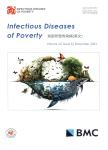Mapping the distributions of blood-sucking mites and mite-borne agents in China:a modeling study
作者机构:State Key Laboratory of Pathogen and BiosecurityBeijing Institute of Microbiology and Epidemiology20 Dong-Da StreetFengtai DistrictBeijing 100071People’s Republic of China 不详 Department of BiostatisticsCollege of Public Health and Health Professions and Emerging Pathogens InstituteUniversity of FloridaGainesvilleFLUSA
出 版 物:《Infectious Diseases of Poverty》 (贫困所致传染病(英文))
年 卷 期:2022年第11卷第2期
页 面:99-99页
核心收录:
学科分类:1004[医学-公共卫生与预防医学(可授医学、理学学位)] 1002[医学-临床医学] 1001[医学-基础医学(可授医学、理学学位)] 100401[医学-流行病与卫生统计学] 10[医学]
基 金:National Institutes of Health, NIH, (R56 AI148284) National Institutes of Health, NIH China National Funds for Distinguished Young Scientists, (81825019) China National Funds for Distinguished Young Scientists National Key Research and Development Program of China, NKRDPC, (2021YFC2302004) National Key Research and Development Program of China, NKRDPC
主 题:Mite Mite-borne pathogen Mite-borne disease Distribution Risk determinant China
摘 要:Background:Emerging mite-borne pathogens and associated disease burdens in recent decades are raising serious public health concerns,yet their distributions and ecology remain under-investigated.We aim to describe the geographical distributions of blood-sucking mites and mite-borne agents and to assess their ecological niches in China.Methods:We mapped 549 species of blood-sucking mites belonging to 100 genera at the county level and eight mite-associated agents detected from 36 species of blood-sucking mites in China during 1978–2020.Impacts of climatic and environmental factors on the ecology of 21 predominant vector mites and a leading pathogen,Orientia tsutsugamushi,were assessed using boosted regression tree(BRT)models,and model-predicted risks were mapped.We also estimated the model-predicted number,area and population size of afected counties for each of the 21 mite species in China.Results:Laelaps echidninus is the leading mite species that potentially afects 744 million people,followed by La.jettmari(517 million)and Eulaelaps stabularis(452 million).Leptotrombidium scutellare is the mite species harboring the highest variety of mite-borne agents including four Rickettsia species and two viruses,followed by Eu.stabularis(2 agents),L.palpale(2)and La.echidninus(2).The top two agents that parasitize the largest number of mite species are O.tsutsugamushi(28 species)and hantavirus(8).Mammalian richness,annual mean temperature and precipitation of the driest quarter jointly determine the ecology of the mites,forming four clusters of major mite species with distinct geographic distributions.High-risk areas of O.tsutsugamushi are mainly distributed in southern and eastern coastal provinces where 71.5 million people live.Conclusions:Ecological niches of major mite species and mite-borne pathogens are much more extensive than what have been observed,necessitating expansion of current fled surveillance.



